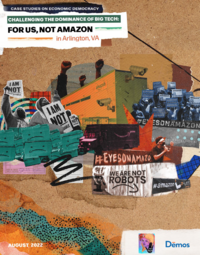In 2018, after 238 cities in the U.S. and Canada submitted competitive bids to become home to Amazon’s highly anticipated second headquarters, or “HQ2,” Amazon announced that it had chosen not 1 site but 2: Queens, New York City and Arlington County, Virginia, near Washington, D.C. Amazon paired its bidding process with a powerful public relations campaign about the range of economic benefits HQ2 would bring. Touting the “prosperity bomb” it had detonated in Seattle, it projected investments of some $5 billion and 50,000 high-tech jobs. But many residents of Virginia and New York feared that only a select class of people would truly benefit. They worried that HQ2 would lead to rising rents, displacing Black, brown, and low-income people. They foresaw increased surveillance, judging from Amazon’s record of partnerships with local police departments.
Community organizers in Arlington felt that Amazon had set up a “race to the bottom” through tax and subsidy deals that pitted cities against one another, each trying to outdo the next with gifts to one of the richest corporations in the world. Good Jobs First, a nonprofit that opposes corporate subsidies, called the HQ2 competition a “monument to high-tech arrogance and taxbreak favoritism.” In an effort to hold Amazon accountable, over 70 organizations representing community members, warehouse and service workers, and faith communities in more than 20 states put forth a set of demands. These included minimum standards for diversity in the workforce, living wages, and investments in transit, housing, and infrastructure.
Shortly after Queens was named 1 of the 2 selected sites, the New York state government promised the company at least $1.7 billion in economic incentives on top of millions more from New York City. The move triggered a backlash from progressive state and federal elected officials, community organizers, and unions. After months of intense resistance, Amazon withdrew its plans for New York City. Instead, it put all of its resources into the site in Northern Virginia. It began by partnering with a local developer, JBG Smith, known for building luxury condominiums that appeal to younger, affluent residents. The idea was to create a new neighborhood, called “National Landing,” out of 3 adjacent districts in Arlington (Crystal City and Pentagon City) and Alexandria (Potomac Yard).
Organizers in New York City were proud to have repelled Amazon but felt pained for their allies in the DC area. While activists and community groups in northern Virginia also tried to fight the coming of HQ2, they had fewer resources and a less developed organizing infrastructure. Amazon’s ability to wield its riches and political power to establish itself in Northern Virginia, even after a high-profile defeat in New York City, was a clear sign of the need for a coordinated, national resistance.
The For Us, Not Amazon (FUNA) coalition formed in late 2018. It grew out of organizing by PowerSwitch Action, a national organization dedicated to building power and reshaping the economy and urban environment for workers and communities. PowerSwitch convened local groups that were concerned about their cities’ bids for HQ2, helping them coordinate messages, demands, and protests. The FUNA coalition then united to stop HQ2 from coming to Northern Virginia—and, when that failed, acted to prevent Amazon from dominating the local economy. FUNA comprises a diverse coalition of consumers, workers, activists, and policymakers who believe that everyone should be able to benefit from economic growth, without having to sacrifice their community’s well-being. FUNA is also a founding member of Athena, itself a coalition of local and national organizations focused on stopping Amazon’s unconstrained growth and influence.

